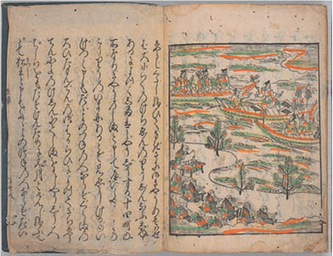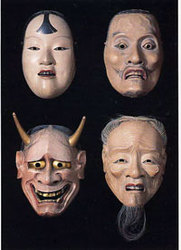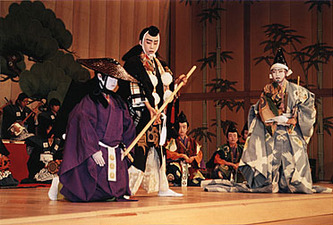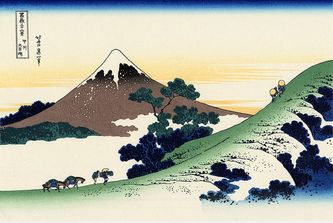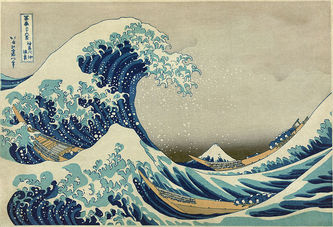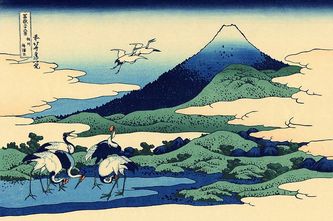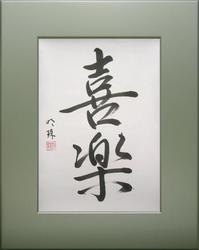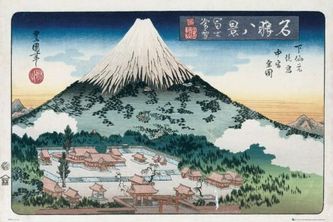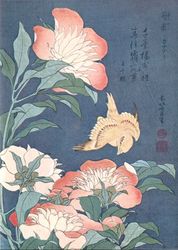Japan's Literature and Drama
Literature in Japanese history flourished at the start of the 1800s. A writing system was developed, several types of drama were created, novels were written, and poetry blossomed.
Japan used the Chinese writing system, using characters, almost small pictures, to symbolize specific objects, actions, or ideas. However, in the 9th century, the Japanese developed kana, which are basically simpler Chinese characters; ‘letters’ that worked similarly to the English alphabet. Each letter stands for a sound, and when you put them together, they form a word. Even so, the Japanese still use Chinese characters today.
Japan’s traditional drama is traced back to the 600s, and began with traditional Shinto dances at shrines. Noh was developed in the 1300s, by actors, and is a special type of drama that often features retellings of legends and folktales presented by actors in painted wooden masks. Noh is the oldest traditional Japanese theatre. The wooden masks helped show different emotions, and the story was told from the various gestures, costumes, and music. Noh was often performed on an outdoor stage. The floors were highly polished, and designed to allow sound to travel when the actors stomp on the shining wood. As a result of this structure, he stage itself is around three feet off the ground. Most of the noh actors were men, and performed for both upper and lower classes.
Kabuki is another type of Japanese classical theater, and began in 1603, presumably by Izumo no Okumi, who was possibly a female shaman. Kabuki includes singing and dancing, and the performers wore very heavy makeup. In kabuki plays, it was strictly forbidden to perform or show anything that insulted or contradicted the shogunate. From 1603 to 1629, only female actresses acted in kabuki. However, females were banned from acting, because they were thought to disgrace the art of kabuki, due to the audiences they were attracting. From then on, kabuki was played by males only, even today.
Kabuki is still popular. A director by the name of Testuji Takechi, wrote many variations of kabuki plays, in a very creative way. Some famous kabuki performers become featured in films and television shows.
One of the very first novels was written in Japan, by a woman called Lady Murasaki Shikibu. She was one of Japan’s greatest writers, and lived in the emperor’s court in the early 1000s. Her most famous work was “The Tale of Genji”, a book telling the story of a prince who lived in court, and was written in the 9th century. This greatly helped the development of literature, because of how it focused on one realistic subject; in this case, a prince. The literature before had all been retold myths, or a several small stories combined into one compilation. Gengi was a realistic, long novel based on one character, making it the first important novel in the world.
During the Heian Era, poetry flourished greatly. In fact, between A.D. 800 and A.D 1200, beauty, especially the beauty of nature, was sought out as much as possible. As a result, gorgeous calligraphy, exquisite clothing, and lush gardens were created, especially poetry. Japanese poetry was often about the sadness of love, or nature’s beauty. Some poems, like haikus, are much shorter than other famous works of poetry in other countries. A haiku is a Japanese form of poem, containing 17 syllables arranged in lines of five, seven, and five syllables.
Unfortunately, due to the sudden focus and interest in discovering beauty, the concentration on government duties lessened. Then, powerful warlords became more independent with the government loosening their hold on them.
Here are some interesting videos:
Japanese Art
In the 8th century, the art of Japan took on a very unique and special style, only found in Japan. Japan’s art nearly always portrays two particular themes: a love of beauty in nature, and simple things. Calligraphy is one form of art that was shared by the Chinese and the Japanese, and started in the 600s. Calligraphy is the art of beautiful writing, and painted using brushed and ink on paper, and sometimes silk. To write the characters, there is a specific order you must write them in, and the particular shape and size you wrote them in changed the meaning of it.
Usually, Japanese designs are very detailed and meticulous, depicting gorgeous landscapes, important historical events, and daily life. Sometimes, the art piece included an explanation written on the piece itself. Japan is known for their spectacular woodblock printing. It was derived from China, which already had types of printing such as movable type. However, the Japanese made it very artistic and beautiful. Here are some of the most famous woodblock printings, which are all in the Thirty-six Views of Mount Fuji by Katsushika Hokusai:
Flower arranging and gardening were very popular, derived from the Buddhists who brought it to Japan, and showed both simplicity and natural beauty. Bonsai is the art of growing miniature trees or shrubs in small pots or trays. They sometimes had small statues next to it, creating a small bench, or several tiny people, to give the impression of a large, grand tree, in a miniature form. Gorgeous, lush Zen gardens were always designed to show the beauty of nature, and offer a place for people to think quietly. Zen is a Japanese form of Buddhism that focuses on self-discipline, simplicity, and meditation.
Some of the world’s oldest, most ancient pottery, was found in Japan. It comes in many different shapes and sizes. Some are coiled, one is more cylindrical, one is small at the bottom and has a wide rim, and some are shaped like vases, with a round body and slim neck. Certain pots have gorgeous, intricate designs on them. They can even have shells that decorate it.
Japan has many forms of art, of which most follow a very unique and special theme. From calligraphy, to paintings, to gardening, Japan has very diverse and beautiful art.
Some of the world’s oldest, most ancient pottery, was found in Japan. It comes in many different shapes and sizes. Some are coiled, one is more cylindrical, one is small at the bottom and has a wide rim, and some are shaped like vases, with a round body and slim neck. Certain pots have gorgeous, intricate designs on them. They can even have shells that decorate it.
Japan has many forms of art, of which most follow a very unique and special theme. From calligraphy, to paintings, to gardening, Japan has very diverse and beautiful art.
